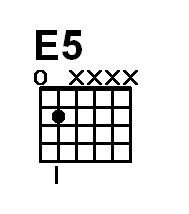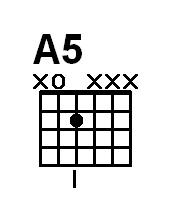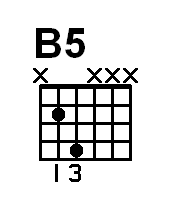 Here is a fun, easy lick from the theme to "Peter Gunn". Even if you have never played guitar before you will be able to play this riff in the next few minutes.
Here is a fun, easy lick from the theme to "Peter Gunn". Even if you have never played guitar before you will be able to play this riff in the next few minutes.
If you've never heard the theme to "Peter Gunn" before then you're probably too young to be here! (Stick around anyhow!)
This lick is played all on one string, the 6th string or low "E".
Take a look at the TAB below. If you are unfamiliar with reading TAB please see "How to Read TAB".

There are four measures in the above TAB but they are all the same. Once you learn one measure you know the whole thing.
You can reduce finger movement by keeping you hand in one position and assigning each finger to a fret. For example: use your 1st finger to play the notes on the 2nd fret, use your 2nd finger to play the notes on the 3rd fret, your 3rd finger to play the notes on the 4th fret, and your 4th finger to play the notes on the 5th fret.
With your picking hand you can use all "down" strokes with the pick.
Enjoy...

Lesson Goals:
♦ Review the open position for the C major chord
♦ Learn to strum down strokes and up strokes
♦ Play the two strumming examples
Basic strumming on the guitar is mainly comprised of playing down strokes and up strokes with the pick. On an acoustic guitar the pick should sweep across the strings in the area of the sound hole. On an electric guitar strumming should take place in the mid body area of the guitar.
This lesson assumes that you already know how to play a C major chord in the open position. We have provided a diagram for you to review the fingering.
Look at the chart below(If you are unfamiliar with reading charts see our tutorial on "Reading Music Charts"). In this example you will play a C major chord using alternating down strokes and up strokes. Work on keeping the strokes smooth and fluid while staying in tempo. Start slow to begin with.

As you can see, each measure consists of 4 beats. On the first beat of each measure you will play a "down" stroke. On the second beat of each measure you will play an "up" stroke. The strokes will simply alternate between down strokes and up strokes throughout all four measures of the example.
Now look at the next chart.

In this example, you will play a down stroke on the first beat. Then, on the second beat you will play a quick "down then up" stroke.
Sometimes, in order to get a better feel for a rhythm pattern, it can be helpful to verbalize it.
If you were to verbalize the rhythm pattern for the complete example above, you would say:
"one, and a, two, and a / one, and a, two, and a / one, and a, two, and a / one..."
Try this slowly and work on accuracy more than speed.
Enjoy...

Lesson Goals:
♦ Review G major chord in the open position
♦ Learn G chord "variation"
♦ Play G chord finger style progression
Here is an easy finger picking riff based on the G major chord in the open position. This riff can be played with only the thumb and the 1st finger. (see "Fret & Finger Numbering")
Take a look at the TAB below. If you are unfamiliar with reading a TAB chart please see "How to Read TAB".

The first measure is based on the G chord in the open position. The easiest way to play this is to form a G chord by placing the 3rd finger on the 3rd fret of the 6th string, the 2nd finger on the 2nd fret of the 5th string, and the 4th finger on the 3rd fret of the 1st string.
Forming the complete chord will make the transition to the G chord "variation" much smoother, even though you will only be using one note (the "root") of the G chord.
In the G chord "variation" you will keep the 3rd finger in place, and then place the 2nd finger on the 2nd fret of the 4th string, and the 1st finger on the 1st fret of the 2nd string.
If you are unsure of the string numbers please see "Naming the Open Strings".
In this progression you will pick the root notes on the 3rd fret of the 6th string with your thumb. All other notes will be picked with the first finger of the picking hand.
Try this very slowly to begin with and get used to the picking pattern before working on speed.
Enjoy...

Lesson Goals:
♦ Learn the proper fingering for the E5, A5 & B5 chords
♦ Play the chords clearly and visualize the chord patterns
♦ Play the three chord progression
Let's get started playing guitar fast with these easy 2 note chords.
The first chord we will work on is the E5 chord.
Look at the diagram below. If you are unfamiliar with reading chord diagrams, refer to the tutorial on "Reading Chord Diagrams". If you need information on naming the open strings and string numbering see our tutorial on "Naming the Open Guitar Strings".

The E5 chord is formed by placing the 1st finger on the 2nd fret of the 5th string and playing that note along with the open 6th string. Give it a try!
The next chord we will work on is the A5 chord. Look at the next diagram.

The A5 chord is played by placing the 1st finger on the 2nd fret of the 4th string and playing that note along with the open 5th string.
Notice that the pattern for the A5 chord is identical to the pattern of the E5 chord. They are both the same shape and played the same way, they are just played on different string positions.
Now let's move on to the B5 chord. Take a look at the next diagram.

The B5 chord is formed by placing the 1st finger on the 2nd fret of the 5th string, and the 3rd finger on the 4th fret of the 4th string. This chord is a little trickier than the previous two because you will be using two fingers to form the chord instead of one. Try it out!
Now let's put these three chords together into a progression. Look at the chart below. If you are unfamiliar with reading music charts, see our tutorial on "Reading Music Charts".

To play this progression you will play the first measure with four beats of the E5 chord. The second measure is four beats of the A5 chord. The third measure is four beats of the B5 chord, and the last measure returns to the E5 chord for another four beats. Play through it and see how it sounds.
Enjoy...

 Here is a fun, easy lick from the theme to "Peter Gunn". Even if you have never played guitar before you will be able to play this riff in the next few minutes.
Here is a fun, easy lick from the theme to "Peter Gunn". Even if you have never played guitar before you will be able to play this riff in the next few minutes.
![]()







